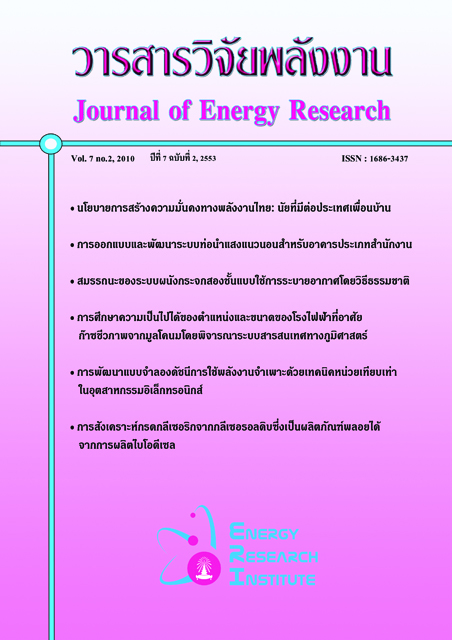การสังเคราะห์กรดกลีเซอริกจากกลีเซอรอลดิบซึ่งเป็นผลิตภัณฑ์พลอยได้จากการผลิตไบโอดีเซล
Main Article Content
Abstract
งานวิจัยนี้สนใจศึกษาการสร้างมูลค่าเพิ่มให้กับกลีเซอรอลดิบ ซึ่งเป็นผลิตภัณฑ์พลอยได้จากกระบวนการผลิตไบโอดีเซล เป็นที่ทราบกันว่าปฏิกิริยาออกซิเดชันของกลีเซอรอลโดยใช้ตัวเร่งปฏิกิริยาฐานทองจะให้กรดกลีเซอริกเป็นผลิตภัณฑ์หลัก สำหรับการศึกษานี้ได้เลือกใช้ตัวเร่งปฏิกิริยาทองระดับนาโนที่มีซิเทรตเป็นสารคงสภาพ และใช้กลีเซอรอลบริสุทธิ์เป็นสารตั้งต้นเพื่อศึกษาหาภาวะที่เหมาะสมต่อการเกิดปฏิกิริยาออกซิเดชัน โดยปัจจัยสำคัญที่ศึกษาได้แก่ อุณหภูมิและเวลาในการทำปฏิกิริยา ความดันแก๊สออกซิเจน ความเข้มข้นของตัวเร่งปฏิกิริยา ความเข้มข้นของสารตั้งต้น และความเข้มข้นของเบสที่ใช้ในปฏิกิริยาออกซิเดชัน ผลการศึกษาพบว่าการออกซิเดชันของกลีเซอรอลที่อุณหภูมิ80 องศาเซลเซียสเป็นเวลา 3 ชั่วโมง ที่ความดันแก๊สออกซิเจน 3 บาร์ ใช้ความเข้มข้นของตัวเร่งปฏิกิริยา 50 ส่วนในล้านส่วน ความเข้มข้นของสารตั้งต้น 0.6 โมลต่อลิตร และอัตราส่วนระหว่างเบสต่อกลีเซอรอลเท่ากับ 1:1 เป็นภาวะที่ดีที่สุดในการออกซิเดชันกลีเซอรอลบริสุทธิ์ กล่าวคือภายใต้ภาวะดังกล่าวให้การเปลี่ยนแปลงของกลีเซอรอลและร้อยละผลได้ของกรดกลีเซอริกเชิงสเปกโตรสโกปีมากที่สุด ในขณะที่ปฏิกิริยาออกซิเดชันของกลีเซอรอลที่ได้มาจากการผลิตไบโอดีเซลภายใต้ภาวะเดียวกันให้ค่าการเปลี่ยนแปลงของกลีเซอรอลและร้อยละผลได้ของกรดกลีเซอริกเชิงสเปก-โตรสโกปีต่ำกว่าเมื่อเทียบกับการใช้กลีเซอรอลบริสุทธิ์เป็นสารตั้งต้น
Synthesis of glyceric acid from crude glycerol by-product from biodiesel production
This project is aim to create value added to crude glycerol which is a by-product from biodiesel production process. The glycerol oxidation using gold based catalyst would gave glyceric acid as main product. The oxidation of glycerol to glyceric acid was studied by using citrate stabilized gold nanoparticles catalyst. An optimum condition was examined by using pure glycerol as a reactant. Effect of reaction temperature, time, oxygen pressure, catalyst concentration, reactant concentration and base concentration on the glycerol oxidation were investigated. It was found that the oxidation of glycerol at 80°C for 3 hours under 3 bars oxygen using 50 ppm catalyst with 0.6 molar reactant and base to glycerol ratio of 1:1 was the optimum condition owing the highest glycerol conversion and spectroscopic yield of glyceric acid of 35.36% and 22.72% respectively. However, the oxidation of crude glycerol under the same condition exhibited the lower glycerol conversion and spectroscopic yield of glyceric acid compared with pure glycerol oxidation.

